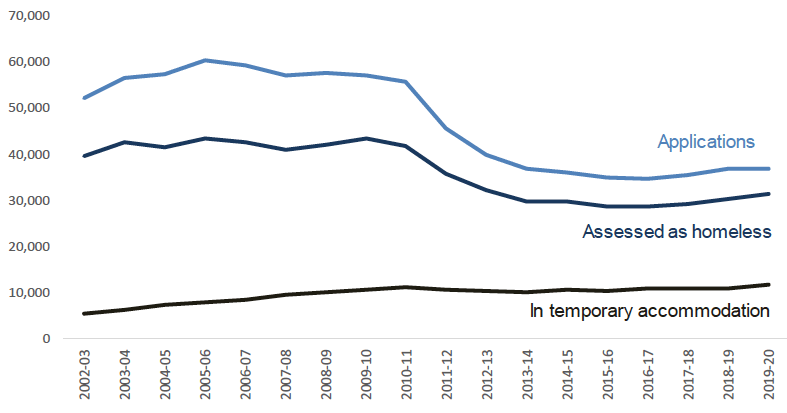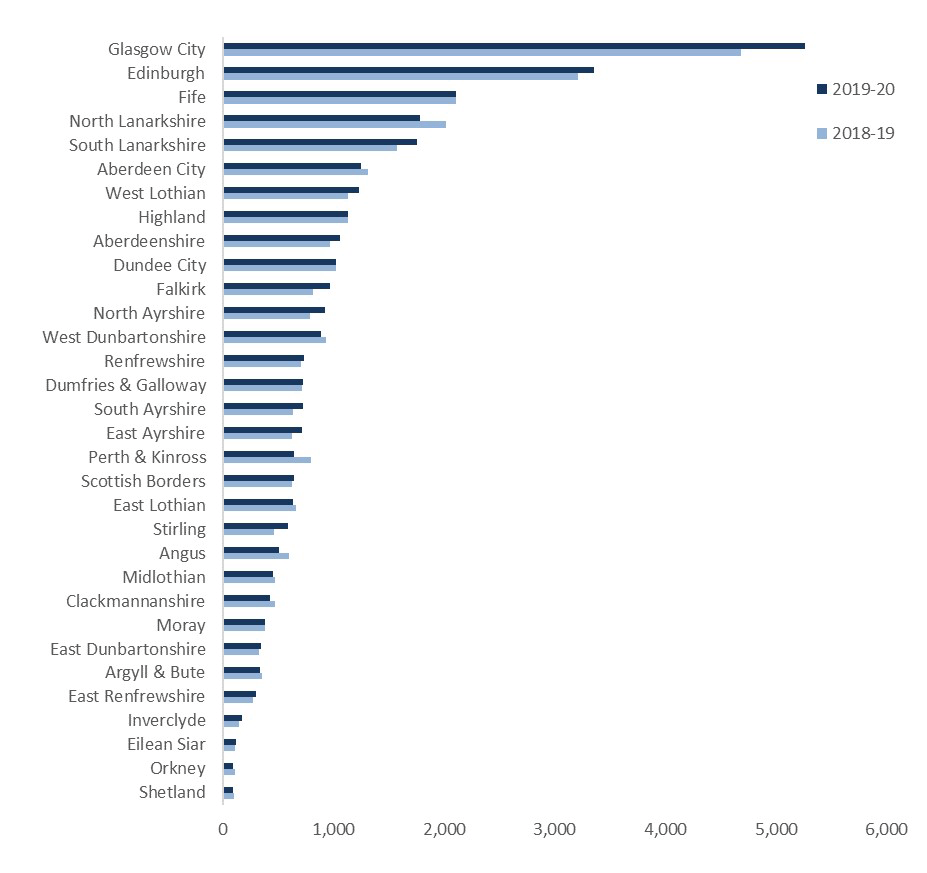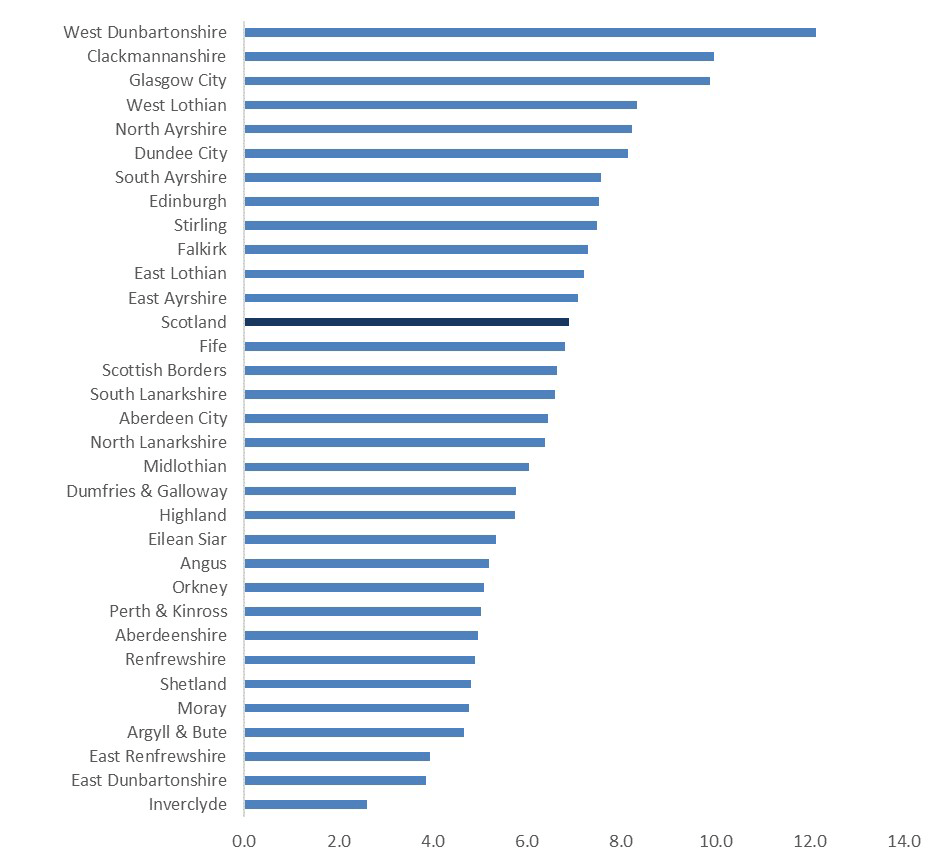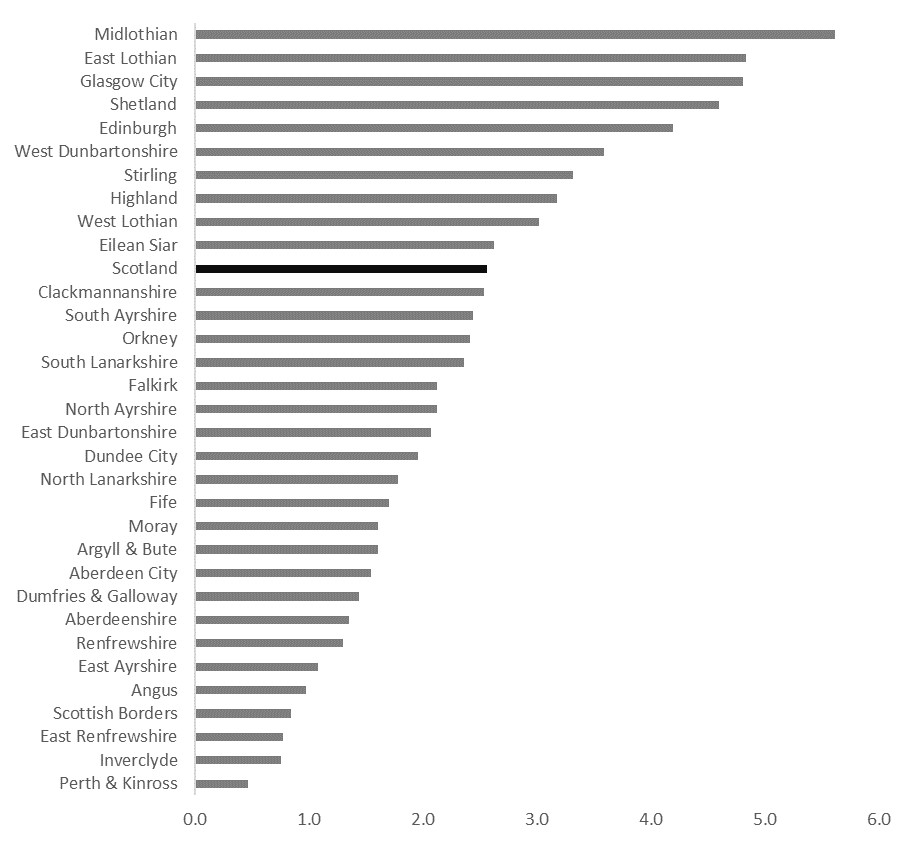Homelessness in Scotland: 2019 to 2020
This statistics bulletin provides information on homelessness in Scotland in the period from 1 April 2019 to 31 March 2020, alongside historical data.
This document is part of a collection
The Extent of Homelessness in Scotland
Key Points
- 31,333 households were assessed as homeless in 2019/20, an increase of 4% compared to 2018/19.
- These households contain 51,365 people, including 35,654 adults and 15,711 children.
- There were 11,665 households and 7,280 children in temporary accommodation at 31st March 2020, increases of 6% and 7% respectively compared to 2018/19.
Applications, assessments and households in temporary accommodation
In 2019/20, local authorities received a total of 36,855 homelessness applications. Over this same time period, 37,336 applications were assessed with 31,333 (84%) found to be homeless or threatened with homelessness. Of these 31,333, 30,146 (96%) were assessed as unintentionally homeless, with the remaining 1,187 assessed as intentionally homeless. (Tables 1 & 7)
As at 31st March 2020, there were a total of 11,665 households in temporary accommodation, 3,570 of which contained a pregant woman or children. (Tables 29 & 30)
Trends over time
Comparisons with the previous year are shown in Table A, with longer term trends in Chart 1.
| 2018/19 | 2019/20 | Change | ||
|---|---|---|---|---|
| Number | Percentage | |||
| Applications | 36,771 | 36,855 | 84 | 0% |
| Assessed as homeless | 30,236 | 31,333 | 1,097 | 4% |
| Households in temporary accommodation at 31st March | 10,989 | 11,665 | 676 | 6% |
Table A shows there has been only a very slight increase in the number of applications between 2018/19 and 2019/20 (84, 0%). This compares to a 4% increase in the number of households assessed as homeless, implying a higher proportion of applications assessed as homeless compared to previously. This is indeed the case, with 84% assessed as homeless in 2019/20 compared to 82% in 2018/19. There is an even larger increase for households in temporary accommodation, which in part may be explained by stays in temporary accommodation increasing .
The number of households with a pregnant woman or children in temporary accommodation increased by 155 (5%) from 3,415 in 2018/19.

Chart 1 shows that the more recent slight increases from 2016/17 in the number of applications and homeless households follow a period of decline since 2009/10. However, the pattern for households in temporary accommodation is quite different between March 2003 and March 2011, with this experiencing a steady increase from 5,403 to 11,254 (5,851, 108%). Between 2012 and 2019, this figure has remained relatively stable - between 10,200 and 11,000 – with a slight increase to 11,665 as at March 2020 in line with the increase in homeless households.
Changes in legislation, policy and practice can help to explain the trends shown in Chart 1. In 2001, Scottish homelessness legislation[1] extended councils' duties to non-priority need homeless households, with the priority need test being abolished on 31st December 2012[2]. Before 2002, the majority of homeless households in priority need were households with children. Following the 2001 extension duty there was a notable increase in the number of single people applying for homelessness assistance. These single people were also eligible for temporary accommodation. This can, at least in part, explain the increases from 2002/03. The sharper decrease shown from 2009/10 is likely due to the impact of the introduction of Housing Options services in Scottish local authorities, with a focus on prevention.
Number of households vs number of people
While data is provided and reported at a household level, local authorities record the number of people attached to applications, and it is therefore possible to understand how many people are affected by homelessness.
The 31,333 households assessed as as homeless in 2019/20 contained a total of 51,365 people. This included 35,654 adults (69%) and 15,711 children (31%) (Tables 12, 13 & 14).
Data is collected for the number of children in temporary accommodation, but not the number of adults. At March 31st 2020 there were 7,280 children in temporary accommodation, an increase of 485 (7%) compred to 6,795 the previous year. (Table 31)
How does homelessness vary across Scotland?

- Glasgow had the highest number of homeless households - 5,262, 17% of the total. This is an increase of 579 (12%) from 2018/19.
- Edinburgh had the next highest with 3,355 (11% of the total), with a smaller increase of 5%.
- There were increases for 18 local authorities in total. Other large increases for South Lanarkshire (180, 11%), Falkirk (152, 19%), North Ayrshire (138, 18%) and Stirling (127, 27%)
Local authority figures can be found in Table 10 of the accompanying data tables.
Glasgow and Edinburgh also had the highest number of households in temporary accommodation, 2,557 and 1,868, respectively, as at 31st March 2020. Glasgow experienced an increase of 366 (17% from 2,191) from 2018/19 and Edinburgh an increase of 353 (23% from 1,515). (Table 29)
Comparing homelessness figures with the population for each local authority (i.e. rates) provides a useful insight as to how homelessness varies across Scotland.

- West Dunbartonshire has the highest rates of 12.1 homeless households per 1,000 population aged 16 or over, followed by Clackmannanshire (10.0) and Glasgow (9.9)
- Inverclyde has the lowest rate of 2.6.
Rates for homeless households can be found in Table 11 of the accompanying data tables.
As part of the assessment stage of a homelessness application, local authorities can investigate whether the applicant has a local connection to the authority to which they applied or to another local authority. This can be on the basis of residency, employment, a family connection or another special reason such as health reasons or education. Where a local connection with another local authority exists the local authority may refer the applicant to that authority, otherwise the duty lies with the authority the application was made to. A local authority may choose not to refer the household e.g. if an application was made for the reason of fleeing from domestic abuse.
In 2019/20, 91% of homeless households had a connection to the local authority to which they made their application. A further 5% had no local connection to any local authority within Scotland. This means, only 4% (1,195) of homeless households had a connection to another local authority other than the one they made an application to. The majority of these were in Glasgow (925, 77% of the total). As Glasgow chose not to refer any cases in 2019/20, this helps explain the disproportionately high levels of homelessness in Glasgow, although does not account for it fully. West Dunbartonshire's high rates of homelessness cannot be explained by those with a local connection elsewhere; 99% of those assessed in West Dunbartonshire had a local connection with that authority only. (Tables 21 & 54)
Interestingly, the use of temporary accommodation does not follow the same pattern (in terms of rates) as the number of homeless households at a local authority level. This implies some local authorities have a disproportionately high use of temporary accommodation, while others are disproportionately low.

- Midlothian has the highest rate of 5.6 households in temporary accommodation per 1,000 population aged 16 or over, followed by East Lothian (4.8) and Glasgow (4.8)
- Perth & Kinross has the lowest rate (0.5)
Rates for temporary accommodation by local authority are detailed in Table 35 of the accompanying data tables.
Contact
There is a problem
Thanks for your feedback